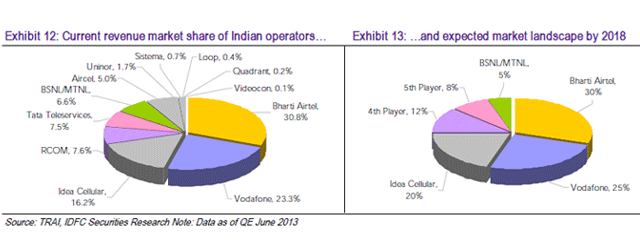Even as the government prepares to announces the much awaited guidelines for mergers and acquisitions (M&A) for the telecom sector in the coming weeks, a report says that new norms make it more conducive for top players to acquire smaller rivals.
The telecom commission has already cleared the new rules, which has increased the subscriber market share of the combined entity from 35 per cent to 50 per cent. The new policy also allows the combined entity to hold up to 50 per cent of the spectrum allotted in any particular frequency band and 25 per cent of the spectrum across bands in the service area. Also in case the target operator has administered spectrum, the acquirer will pay the market price for the same.
"The above norms (if implemented) would rule out consolidation among the top three operators (Airtel, Vodafone and Idea). However, the new norms would facilitate acquisition of smaller rivals. We expect meaningful consolidation in the bottom half of the market with only two-three of the 4th-8th operators surviving in the long run. We expect the Indian market to have five-six operators (including one public sector unit) in the long run with top three accounting for 75 per cent of the market," said the report by IDFC Securities.

Various news reports have indicated that talks for consolidation in the sector have already started. One report said Tata Teleservices (where Japan's DoCoMo is an investor), Sistema and Aircel (owned by Malaysia's Maxis) are in talks for a three way merger. Another report indicated that Bharti Airtel has emerged as frontrunner to acquire Loop Mobile, the fourth-largest operator in Mumbai.
Some of the scenarios highlighted in IDFC report include Vodafone acquiring Quadrant Televentures, he sixth-largest operator in Punjab;
Idea Cellular buying Loop Telecom and Idea Cellular acquiring Aircel.
Another possible scenario could be a piecemeal acquisition of Aircel as it has highly concentrated revenues in select legacy circles which could make it hard to find a single buyer.
"Consolidation in bottom half of the market should impart sustainable pricing power to operators. With five-six larger operators, competition
will likely be rational and not entirely price-driven despite their deeper pockets. In fact, after cut-throat competition in the last few years, larger operators are already showing inclination for profitable growth," added the report.
(Edited by Joby Puthuparampil Johnson)